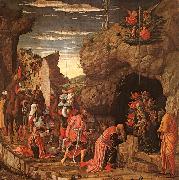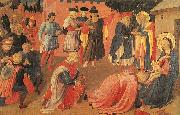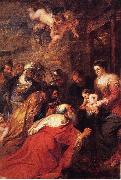
Oil On
Canvas, Real Flavor of Old Masters
|
Leonardo Da Vinci
|
|||
|
|
|||
|
|
|||
|
|
Adoration of the Magi Leonardo Da Vinci11.jpg Painting ID:: 1104 Visit European Gallery |
Florence | |
Height Width |
INS/CM |
||
|
X |
|
||
|
|
|||
|
Andrea Mantegna
|
|||
|
|
|||
| Italian 1431-1506 Andrea Mantegna Locations Mantegna was born in Isola di Carturo, close to Padua in the Republic of Venice, second son of a carpenter, Biagio. At the age of eleven he became the apprentice of Francesco Squarcione, Paduan painter. Squarcione, whose original vocation was tailoring, appears to have had a remarkable enthusiasm for ancient art, and a faculty for acting. Like his famous compatriot Petrarca, Squarcione was something of a fanatic for ancient Rome: he travelled in Italy, and perhaps Greece, amassing antique statues, reliefs, vases, etc., forming a collection of such works, then making drawings from them himself, and throwing open his stores for others to study. All the while, he continued undertaking works on commission for which his pupils no less than himself were made available. San Zeno Altarpiece, (left panel), 1457-60; San Zeno, VeronaAs many as 137 painters and pictorial students passed through Squarcine's school, which had been established towards 1440 and which became famous all over Italy. Padua was attractive for artists coming not only from Veneto but also from Tuscany, such as Paolo Uccello, Filippo Lippi and Donatello. Mantegna's early career was shaped indeed by impressions of Florentine works. At the time, Mantegna was said to be a favorite pupil; Squarcione taught him the Latin language, and instructed him to study fragments of Roman sculpture. The master also preferred forced perspective, the lingering results of which may account for some Mantegna's later innovations. However, at the age of seventeen, Mantegna separated himself from Squarcione. He later claimed that Squarcione had profited from his work without paying the rights. His first work, now lost, was an altarpiece for the church of Santa Sofia in 1448. The same year Mantegna was called, together with Nicol?? Pizolo, to work with a large group of painters entrusted with the decoration of the Ovetari Chapel in the apse of the church of Eremitani. It is probable, however, that before this time some of the pupils of Squarcione, including Mantegna, had already begun the series of frescoes in the chapel of S. Cristoforo, in the church of Sant'Agostino degli Eremitani, today considered his masterpiece. After a series of coincidences, Mantegna finished most of the work alone, though Ansuino, who collaborated with Mantegna in the Ovetari Chapel, brought his style in the Forl?? school of painting. The now censorious Squarcione carped about the earlier works of this series, illustrating the life of St James; he said the figures were like men of stone, and had better have been colored stone-color at once. This series was almost entirely lost in the 1944 Allied bombings of Padua. The most dramatic work of the fresco cycle was the work set in the worm's-eye view perspective, St. James Led to His Execution. (For an example of Mantegna's use of a lowered view point, see the image at right of Saints Peter and Paul; though much less dramatic in its perspective that the St. James picture, the San Zeno altarpiece was done shortly after the St. James cycle was finished, and uses many of the same techniques, including the classicizing architectural structure.) San Luca Altarpiece, 1453; Tempera on panel; Pinacoteca di Brera, MilanThe sketch of the St. Stephen fresco survived and is the earliest known preliminary sketch which still exists to compare to the corresponding fresco. Despite the authentic look of the monument, it is not a copy of any known Roman structure. Mantegna also adopted the wet drapery patterns of the Romans, who derived the form from the Greek invention, for the clothing of his figures, although the tense figures and interactions are derived from Donatello. The drawing shows proof that nude figures were used in the conception of works during the Early Renaissance. In the preliminary sketch, the perspective is less developed and closer to a more average viewpoint however. Among the other early Mantegna frescoes are the two saints over the entrance porch of the church of Sant'Antonio in Padua, 1452, and an altarpiece of St. Luke and other saints (at left) for the church of S. Giustina, now in the Brera Gallery in Milan (1453). As the young artist progressed in his work, he came under the influence of Jacopo Bellini, father of the celebrated painters Giovanni and Gentile, and of a daughter Nicolosia. In 1453 Jacopo consented to a marriage between Nicolosia to Mantegna in marriage. | |||
|
|
|||
|
|
Adoration of the Magi Andrea Mantegna3.jpg Painting ID:: 2717 Visit European Gallery |
Galleria degli Uffizi, Florence | |
Height Width |
INS/CM |
||
|
X |
|
||
|
|
|||
|
Fra Angelico
|
|||
|
|
|||
| Fra Angelico Galleries b.c. 1400, Vicchio, Florence d.Feb. 18, 1455, Rome Fra Angelico (c. 1395 ?C February 18, 1455), born Guido di Pietro, was an Early Italian Renaissance painter, referred to in Vasari's Lives of the Artists as having "a rare and perfect talent". Known in Italy as il Beato Angelico, he was known to his contemporaries as Fra Giovanni da Fiesole (Brother John from Fiesole). In Giorgio Vasari's Lives of the Artists, written prior to 1555, he was already known as Fra Giovanni Angelico (Brother Giovanni the Angelic One). Within his lifetime or shortly thereafter he was also called Il Beato (the Blessed), in reference to his skills in painting religious subjects. In 1982 Pope John Paul II conferred beatification, thereby making this title official. Fiesole is sometimes misinterpreted as being part of his formal name, but it was merely the name of the town where he took his vows, used by contemporaries to separate him from other Fra Giovannis. He is listed in the Roman Martyrology as Beatus Ioannes Faesulanus, cognomento Angelicus??"Blessed Giovanni of Fiesole, nicknamed Angelico". Fra Angelico was working at a time when the style of painting was in a state of change. This process of change had begun a hundred years previous with the works of Giotto and several of his contemporaries, notably Giusto de' Menabuoi, both of whom had created their major works in Padua, although Giotto was trained in Florence by the great Gothic artist, Cimabue, and painted a fresco cycle of St Francis in the Bardi Chapel in Santa Croce. Giotto had many enthusiastic followers, who imitated his style in fresco, some of them, notably the Lorenzetti, achieving great success. | |||
|
|
|||
|
|
Adoration of the Magi Fra Angelico8.jpg Painting ID:: 3254 Visit European Gallery |
1433-35 Museo San Marco, Florence | |
Height Width |
INS/CM |
||
|
X |
|
||
|
|
|||
|
Peter Paul Rubens
|
|||
|
|
|||
| Flemish Baroque Era Painter, 1577-1640 Peter Paul Rubens (June 28, 1577 ?C May 30, 1640) was a prolific seventeenth-century Flemish Baroque painter, and a proponent of an exuberant Baroque style that emphasized movement, color, and sensuality. He is well-known for his Counter-Reformation altarpieces, portraits, landscapes, and history paintings of mythological and allegorical subjects. In addition to running a large studio in Antwerp which produced paintings popular with nobility and art collectors throughout Europe, Rubens was a classically-educated humanist scholar, art collector, and diplomat who was knighted by both Philip IV, king of Spain, and Charles I, king of England. Rubens was a prolific artist. His commissioned works were mostly religious subjects, "history" paintings, which included mythological subjects, and hunt scenes. He painted portraits, especially of friends, and self-portraits, and in later life painted several landscapes. Rubens designed tapestries and prints, as well as his own house. He also oversaw the ephemeral decorations of the Joyous Entry into Antwerp by the Cardinal-Infante Ferdinand in 1635. His drawings are mostly extremely forceful but not detailed; he also made great use of oil sketches as preparatory studies. He was one of the last major artists to make consistent use of wooden panels as a support medium, even for very large works, but he used canvas as well, especially when the work needed to be sent a long distance. For altarpieces he sometimes painted on slate to reduce reflection problems. His fondness of painting full-figured women gave rise to the terms 'Rubensian' or 'Rubenesque' for plus-sized women. The term 'Rubensiaans' is also commonly used in Dutch to denote such women. | |||
|
|
|||
|
|
Adoration of the Magi Peter Paul Rubens2.jpg Painting ID:: 3642 Visit European Gallery |
King's College Chapel, Cambridge, UK | |
Height Width |
INS/CM |
||
|
X |
|
||
|
|
|||










